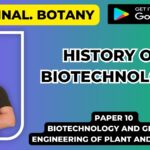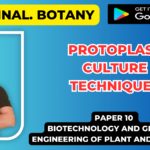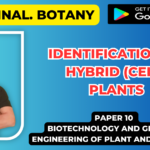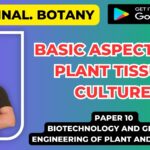![]()
Plant tissue Culture General Introduction
- PTC refers to the in vitro cultivation of plant seed and various parts of the plant.
- The cultivation process was carried out in a nutrient culture medium under aseptic conditions.
- Plant tissue culture is one of the most rapidly growing areas of biotechnology Because of its high potential to develop improved crops and ornamental plants.
- By the advance made of the tissue culture technique, it is now possible to regenerate species of any plant in the laboratories.
- To achieve the target of creating a new plant or a plant coupled with recombinant DNA technology .
- The techniques of plant tissue culture have largely helped in the green revolution by improving” the crop Yield and quality.
- The knowledge obtained from plant tissue culture has Contributed to our understanding of metabolism, growth differentiation, and the morphogenesis of plant cells.
- Further development in tissue culture have helped to produce several pathogen free plant beside the synthesis of many biologically important compound including pharmaceutics, Because or the world wide use of plant tissue culture attract the attention of molecular biologist, plant breeders and industrialist,
The basic structure and growth of a plant
- An adult plant has a stem and a root both have apical meristem which are composed of meristematic cells. These cells are the primary source for all the cell types of a plant .
- The plant growth and development – occurs in two different ways.
- 1.Determinate Growth – This is a growth in which plant parts attain a certain size and shape e.g. Leaves flowers bruits.
- 2. Indeterminate growth – This is a continuous growth of roots and stems under suitable conditions. It is possible due to the presence of meristem which can proliferate continuously. As the seed germination and seedling emerges the meristematic cells of the root apex multiply. As the plant grows, root cells differentiate into phloem and xylem phloem is responsible for the absorption of nutrients while xylem absorbs water.
- The meristematic cells of the shoot apex divide leading to the growth of stem. Some of the stem cells differentiate and develop into leaf primordia and then leaves. Axillary buds present between the leaf primordia and elongated stem also possess meristems which can multiply and give rise to branches and flowers.

TERMS USED IN TISSUE CULTURE
A selected list of the most commonly used terms in tissue culture are briefly explained
Explant :
An excised piece of differentiated tissue or organ is regarded as an explant The explant may be taken from any part of the plant body e.g., leaf, stem, root.
Callus :
The unorganized and undifferentiated mass of plant cells is referred to as callus. Generally, when plant cells are cultured in a suitable medium, they divide to form callus i.e., a mass of parenchymatous cells.
Dedifferentiation :
The phenomenon of mature cells reverting to a meristematic state to produce callus is dedifferentiation.
Dedifferentiation is possible since the non dividing quiescent cells of the explant, when grown in suitable culture medium revert to a meristematic state.
Redifferentiation –
The ability of the callus cells to differentiate into a plant organ or a whole plant is regarded as redifferentiation.
Totipotency –
The ability of an individual cell to develop into a whole plant is referred to as cellular totipotency. The inherent characteristics of plant cells namely dedifferentiation and redifferentiation are responsible for the phenomenon of totipotency.













